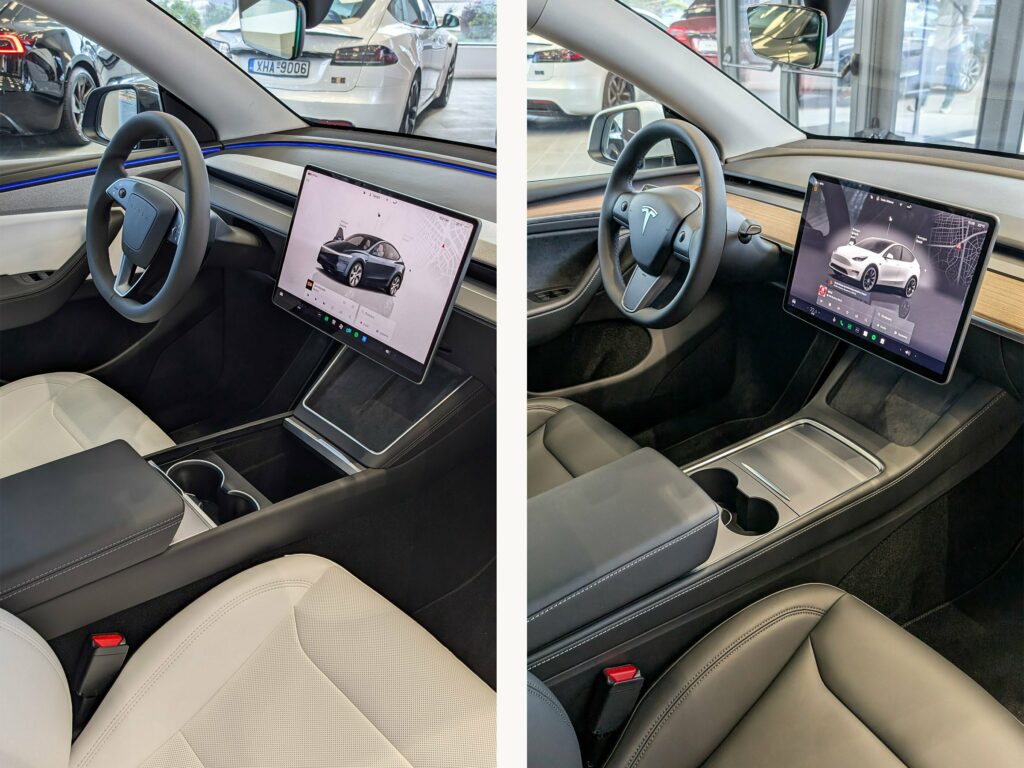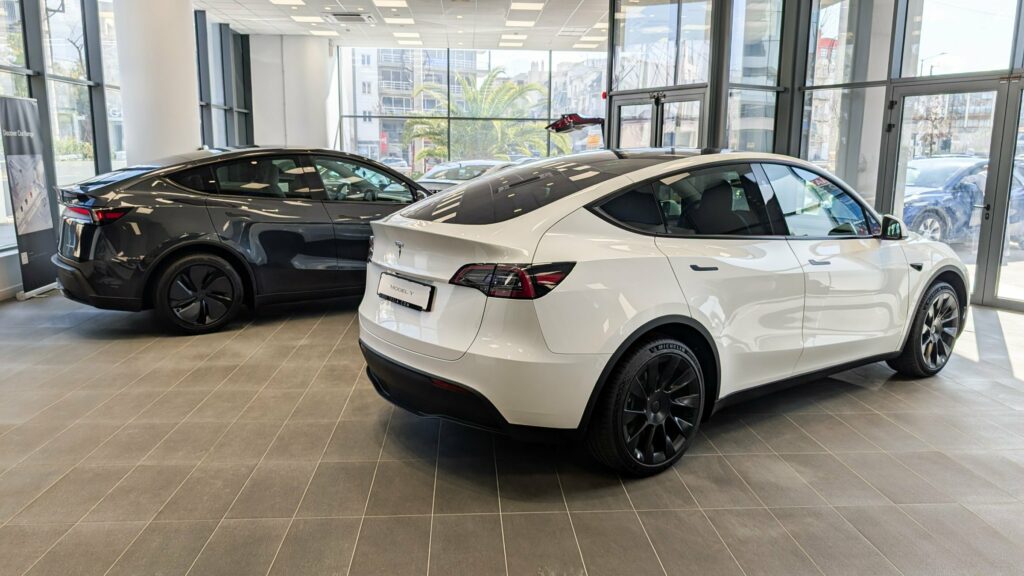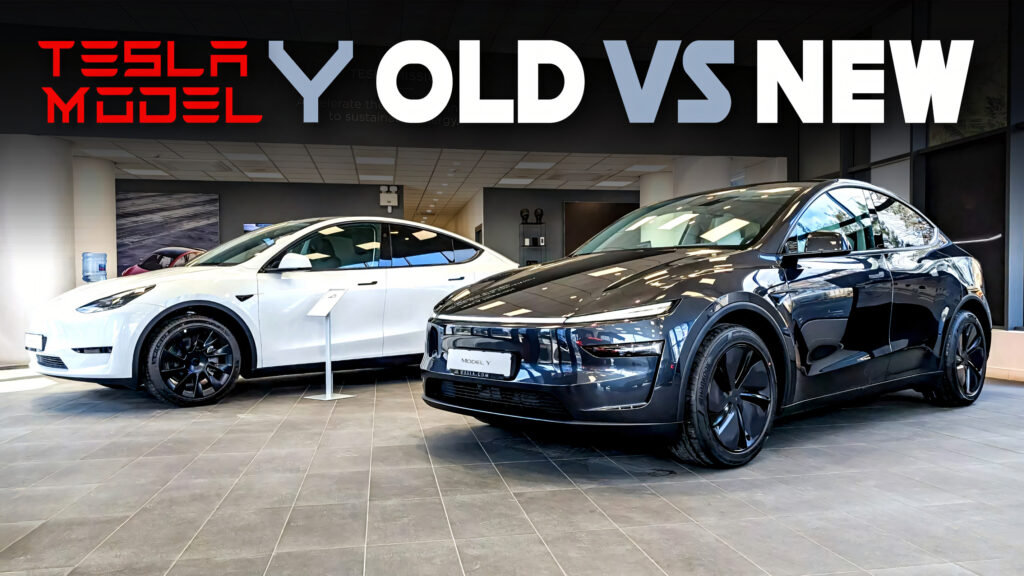With the Tesla Model Y holding its ground as one of the world’s top-selling vehicles across all powertrains, the 2026 update has understandably become one of the most anticipated launches of the year. The facelifted Model Y introduces a range of exterior, interior, and chassis upgrades, promising to refine the world’s best-selling EV. With deliveries of the refreshed model just beginning, we recently visited a Tesla dealership in Greece for a closer look at the changes.
The Model Y’s so-called “Juniper” update that follows the “Highlander” revisions for the Model 3, was revealed last month. As expected, the first cars have already hit dealerships worldwide, and some have even started offering demo drives to potential buyers. While our own test drive is still a few weeks away, we managed to park the refreshed Model Y next to its predecessor for a side-by-side comparison.
Sharper Front and Subtle Tweaks
Let’s be honest: even hardcore Tesla fans have to admit that the original Model Y was a bit of an awkward sibling to the Model 3. Sure, the rear design worked for a crossover, but that roofline was questionable, and the front end was more “needs improvement” than “wow.” It took time to warm up to it—if you ever did.
More: Tesla Rolls Out Standard 2026 Model Y Range In Europe, Cuts Prices By Up To $2,100
Now, hot take alert: despite the endless complaints online about the Cybertruck-inspired front light bar, in person, it actually works.
The Juniper update ditches the awkward duck-face bumper and replaces it with a fresh pair of split headlights that are noticeably different from the Model 3 Highland’s setup. The full-width LED bar at the front brings some Cybercab and Cybertruck vibes but, thankfully, without the latter’s jagged edges or those comically bad panel gaps.
The main headlights are now mounted lower, flanking the revised front bumper with taller side intakes. These tweaks contribute to improved aerodynamics (0.22 drag coefficient vs. 0.23 in the previous model), which should, in theory, boost range—though the battery options remain unchanged.
While the profile largely stays the same, you’ll notice new mirror caps and the more striking design of the 19-inch Crossflow wheels (those are standard on the pictured Launch Series Dual Motor). They look far more appealing than the old 20-inch Helix 2.0 wheels, at least to our eyes.
As for the color palette, the Model Y now comes in Stealth Gray, Pearl White Multi-Coat, Quicksilver, Ultra Red, and Glacier Blue. But if you’re in the market outside of Europe, your options may differ.
More: Should Tesla Give The Model 3 A Juniper Update?
Back-End Changes: LED Afterburners
Moving to the rear, the standout feature is the “indirect reflective body panel taillight.” It’s sleek and far less generic than the previous design, with a glowing LED strip under the dark-tinted cluster that creates a visible “afterburner” effect when driving in the dark.
The Tesla lettering continues the sci-fi theme, replacing the traditional “T” emblem, which is now only found on the wheels. Interestingly, in most markets outside China, the updated Model Y doesn’t carry a badge on its nose, with Tesla confident that its distinctive styling will be enough for people to recognize it.
Lastly, the tailgate features a cleaner design, reminiscent of the Tesla Cybercab, and extends all the way to the more prominent rear bumper, reducing panel gaps. As a result, the length of the crossover has increased by 41 mm (1.6 inches), bringing it to 4,792 mm (188.7 inches). However, the size difference is so subtle that it’s practically undetectable to the naked eye.
You’ll also notice that the tailgate is now split into two pieces. While this may disrupt the visual flow slightly, it’s a practical change—if damaged, the split design makes it cheaper and easier to replace.
Interior: Better Materials, More Screens, Same Tesla
At first glance, the interior of the updated Model Y still feels very much like the old one, but take a closer look, and you’ll notice the details have been improved. The materials are slightly more refined, though you’d need a keen eye (or an obsessive Tesla fan) to catch the difference.
The biggest updates are lifted straight from the Model 3 Highland, including the redesigned steering wheel, a new ambient lighting strip around the cockpit, new dashboard inserts, and—finally—ventilated front seats. Tesla has also reworked the center console and the (larger) door cards, though, in typical Tesla fashion, the overall functionality remains largely unchanged.
More: Tesla Suing Customers And Journalists To Silence Critical Reviews, And It’s Winning, Report Finds
Tesla also made the curious (though not entirely surprising) choice to move the drive controls to the touchscreen, ditching the steering-wheel-mounted gear selector. On the bright side, they’ve kept the turn signal stalk, an obvious win compared to the Model 3’s touch-button alternatives. That said, the stalk itself now has a shorter throw than before.
In both the old and the new Model Y, all functions are still controlled via the 15.4-inch central display, and yes, Tesla continues to stubbornly avoid adding physical buttons, an instrument cluster, or a head-up display. These features are standard in most other cars, but Tesla’s sticking to its guns here.
The 2026 Model Y also gets a blind spot indicator, but in true Tesla cost-cutting fashion, it’s just a tiny single-pixel light in the corner of the window, rather than the more conventional mirror-mounted indicator most other automakers use.
Those sitting at the back will notice the addition of a new 8-inch display giving them access to temperature control and media, although its position is far from ideal for watching movies. More importantly, the rear seats are noticeably more comfortable, now offering additional reclining positions.
Rear visibility remains extremely poor, although the sensors and the live-view of the surroundings on the touchscreens supposedly make up for it.
The boot appears unchanged, but the Model Y Juniper now includes a button that electronically folds and unfolds the rear seat back, making it easier to transport larger items. These adjustments are controlled electronically and even move the front seats forward if they’re unoccupied. Additionally, the frunk now comes with a drain plug, a feature that was absent in the previous Model Y, clearly inspired by its Ford Mustang Mach-E rival.
Reworked Chassis And Carry-Over Powertrains
Tesla hasn’t made any changes to the electric motors or battery packs in the standard models (we’re still waiting for the Performance trim, which should bring more power, among other upgrades). The Model Y (depending on the market) is still available in RWD, Long Range RWD, Long Range AWD, and the upcoming Performance version.
More: Jay Leno Drives 2026 Tesla Model Y, Performance Trim Coming Soon
2026 Tesla Model Y
Thanks to improvements in aerodynamics, tires, and brakes, the Model Y Juniper sees a modest increase in range (EPA-estimated up to 320 miles / 515 km) and also appears to be slightly quicker than its predecessor in equivalent trims—at least on paper.
The real news here is the reworked suspension, which is said to improve ride quality and reduce NVH (Noise, Vibration, Harshness), especially in combination with the new acoustic glass and quieter tires. We couldn’t take it out for a spin at the time we visited the showroom, but considering the previous Model Y’s rough ride on poorly maintained roads, there’s definitely room for improvement here.
Verdict

After spending some time with the 2026 Model Y, it’s clear Tesla’s designers and engineers approached this mid-cycle update with caution. They’ve addressed some of the weak spots in the previous model while keeping the core character of the car largely intact. And with fierce competition coming from China, it’s no surprise they didn’t want to rock the boat too much.
The Model Y Juniper features sharper styling and a more refined cabin, with a range of small upgrades that collectively enhance the overall experience. It’s also more efficient and marginally quicker than its predecessor, which are key factors that should resonate with mainstream buyers. The one remaining piece of the puzzle is the reworked chassis, which could address the most significant flaw of the outgoing model: its ride quality. We’re eager to see how it performs on the road, and we’ll share our full verdict in a more detailed review soon.
Until then, check out the visual comparison in the video and let us know which generation of the Model Y you prefer based on looks. It’ll be interesting to see how the launch of the updated electric crossover affects Tesla’s sales this year, and whether its popularity will be influenced by the growing controversies surrounding the brand’s CEO.







































































